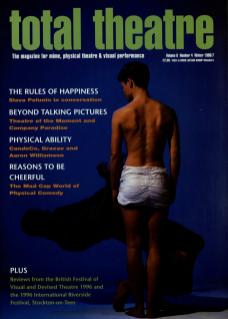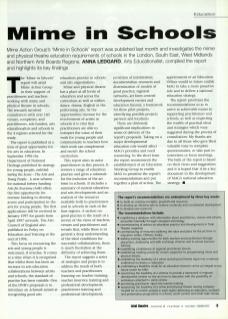The 'Mime in Schools' report will assist Mime Action Group in their support of practitioners and teachers working with mime and physical theatre in schools. The research involved consultation with over 140 venues, companies, and practitioners, arts funders, arts educationalists and schools in the four regions selected for the study.
The report is published at a time of great opportunity for the arts in education. In September 1996 the Department of National Heritage published its strategy for young people, entitled ‘Setting the Scene – The Arts and Young People’. A new scheme for national lottery funding, Arts for Everyone (A4E), offers the first opportunity for revenue funding to develop access and participation in the arts for young people. The first applications will be received in January 1997 for grants from April 1997 onwards. The Arts Council of England also published its Policy on Education and Training at the end of 1996.
This focus on resourcing the arts and young people is welcomed, if overdue. It comes at a time when it is recognised that whilst there has been an increase in arts education collaborations between artists and schools, the standard of practice has been variable. One of the DNH's proposals is to introduce an Artsmark aimed at recognising good arts education practice in schools and arts organisations.
Mime and physical theatre has a place at all levels of education and across the curriculum as well as within dance, drama, English or the performing arts. As the opportunities increase for the involvement of artists in schools it is vital that practitioners are able to interpret the value of their work for young people and communicate to teachers how their work can complement and enrich the school curriculum.
This report aims to assist practitioners in this process. It reviews a range of education practice and gives a rationale for the inclusion of the artform in schools. It includes a summary of current education and arts developments and an analysis of the resources available both to practitioners and to schools in each of the four regions. A section on good practice is the result of a survey of the views of teachers, venues and practitioners and reveals that, while there is in general a deep understanding of the ideal conditions for successful collaborations, there is much frustration at the difficulty of achieving them.
The report suggests a series of strategies and projects to address the needs of both teachers and practitioners focusing on: teacher training; teacher in service training and professional development; practitioner training and professional development; provision of information; documentation resources and dissemination of models of good practice; regional networks, artform centred development centres and education forums; a framework for three pilot projects, identifying possible projects partners and locations.
There are obviously significant implications in terms of delivery of the report's proposals. Taking on a major developmental education role would affect MAG's priorities and need resourcing. In the short term the report recommends the establishment of an Education Working Group to enable MAG to prioritise the report's recommendations and put together a plan of action. The appointment of an Education Officer would in future enable MAG to take a more proactive role and to deliver a national education strategy.
The report prioritises the recommendations so as to arrive at achievable routes to supporting practitioners and schools, as well as respecting the wealth of practical ideas and strategies which were suggested during the process of consultation. My thanks are due to all those who gave their valuable time to complete questionnaires, or take part in interviews or focus meetings. The bulk of the report is based on their views and suggestions and it is hoped that it be a key document in the development of MAG's national education strategy.
The recommendations include: establishing a database with information about practitioners, venues and schools, accessible nationally through computer technology; commissioning of articles on education practice and developments in Total Theatre Magazin; commissioning of resources outlining the value and place for the artform in education (video, CD-Rom, Packs); seeking training opportunities for both teachers and practitioners through placement, shadowing and skills exchange schemes and in-school in-service training; establishing a framework of regional practitioner forums; establishing meeting points for venues supportive to programming mime and physical theatre; establishing the feasibility of a mime and physical theatre input into a national conference on drama in education; undertaking a feasibility study for an education resource centre as integral to any future centre for MAG; researching the feasibility of a scheme to provide a framework of regional development centres for the artform in education with the possibility of animateurs attached to some centres promoting practitioner input into teacher training; researching the feasibility of a mime and physical theatre touring company located for six-month periods in each region delivering an education, outreach and performance programme in schools, youth centres and small scale venues.

